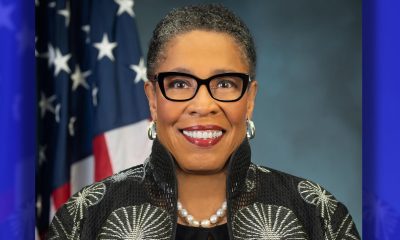Black History
IN MEMORIAM: Remembering the life of Doris Turner Keys, a Civil Rights and Union Icon
NNPA NEWSWIRE — “I believe some of her endearing qualities was her unabiding love of family and friends, her big heart and generous spirit which always had her helping others, her unwavering commitment to pursuing social justice and helping working class people, and her ability to walk with kings and queens while keeping the common touch,” said Doris Turner Keys’ goddaughter, Karen Towns.

Photos Courtesy of the family of Doris Turner Keys
By Stacy M. Brown, NNPA Newswire Contributor
@StacyBrownMedia
Doris Turner Keys answered to many names – Doris, D, D.T., Dot, Doris Turner, Ms. Turner, Tish, Mrs. Keys, Mama Keys, Ma, Grandma, Aunt Doris (and more). But, those who knew her best remember her simply as a loving and caring individual who routinely sought to help others in need.
A noted civil rights and union leader, Keys served in many capacities that championed the causes of worker and civil rights as well as freedom, justice and equality.
Keys passed away in December. She was 88.
She was a longtime Labor and Industry Chairperson for the New Rochelle (N.Y.) Chapter of the NAACP.
At Keys’ recent celebration of life service, former Mount Vernon, N.Y., Mayor Ernest D. Davis and Local 1199 President George Grisham were among those who offered their respect.
Dr. Hazel N. Dukes, president of the NAACP New York State Conference and member of the NAACP National Board of Directors, wasn’t able to attend but had previously noted the contributions Keys made in advancing civil and social justice.
Keys’ goddaughter, Karen Towns, said she watched and learned from Keys at a young age and the matriarch had a great influence on her.

Photos Courtesy of the family of Doris Turner Keys
“Her legacy will live in the tens of thousands of people whose lives she touched. Whether [they are] those 1199 members who benefitted from the advancements of labor contracts that provided wages where they could take could take care of their families and send their kids to college; those who had better housing because of the housing plaza in east Harlem that opened during her tenure; [or] students who received college scholarships from the union which enabled many to be the first in their families to go to college,” Towns said.
She continued:
“Whether they are among those in the communities of Mt. Vernon and New Rochelle and elsewhere where through her church she cooked meals for the homeless every Saturday; as an entrepreneur she provided job opportunities and as a property owner she provided quality, affordable housing for families and commercial space for other entrepreneurs.
“And for her beloved family she has left an abundance of love along with a rich legacy of service, leadership and a constant reminder that we must always be doing something to make things better for others.”
The first-born daughter of Roy L. Turner and Luticia Stewart, Keys was born in Pensacola, Florida on June 20, 1930 at 8:00A.M. in the morning, according to her obituary.
Her early years were spent in Pensacola before moving to New York City. She was reared by her maternal grandmother, Clora Stewart, whose strict discipline and strong religious upbringing became the foundation and catalyst for her life’s mission and work.
Keys attended Booker T. Washington High School, graduating in the class of 1948, in Pensacola, Florida.
In 1956, Keys began work at Lenox Hill Hospital as a clerk in the dietary department.
In 1958, five of New York City’s largest hospitals went on strike for the first time in history with Keys active in leading a successful walkout at Lenox Hill Hospital.
The strike resulted in the beginning of organizing the poorly paid hospital workers in the city as Keys and others lobbied Gov. Nelson Rockefeller to support legislation for the hospital workers with the right to organize and bargain collectively.
She was one of four sitting at the table with Rockefeller as he signed the bill into law.
In 1960, Keys became an organizer for District 1199, which was then primarily a union of pharmacists and other drug store workers.
In 1968, after serving as an organizer, Keys became the director of 1199’s hospital division, the union’s largest division with some 40,000 members. Keys was later elected Executive Vice President of 1199.
In May of 1982, she was elected President of District 1199, winning the election by a 5-to-1 margin, becoming the largest AFL-CIO local union in the United States to be headed by a Black woman.
“Twenty-five years ago, when I came to this union, I never dreamed I would become its president,” Keys said at her swearing-in ceremony. “I also, never dreamed we would ever encounter so much division amongst us.” The election was the most hotly contested ever in District 1199.
Under Keys’ leadership, the union grew from 70,000 to over 130,00 members. As the New York union was growing, Keys was instrumental in organizing workers in New Jersey, Philadelphia, Maryland and Connecticut.
During that time, the Southern Christian Leadership Conference, under the leadership of Rev. Dr. Martin Luther King Jr., called upon the union for help on behalf of some hospital workers in Charleston, South Carolina, a group of 500 Black women and 3 Black men.
After King’s death, Keys went to Charleston and worked with Coretta Scott King to help establish an organization of workers.
Later, they traveled to John Hopkins University in Maryland and Boston University in Massachusetts to talk to leaders, workers and community activists in the effort to continue the struggles to organize health care workers.
District 1199 was among the first unions to speak out against the Vietnam War and Keys represented the union at a protest march.
When more than a dozen hospitals were threatening to close in New York, District 1199 joined with other unions and marched on Albany demanding that the governor call a special session of the State Legislature to restore the budget cuts in Medicaid, welfare, school lunch and other programs that was so sorely needed in the poorest communities.
The march proved successful and Keys went on to become the first woman vice president of the RWDSU/AFL-CIO.
Keys spent the final 52 years of her life living in Mount Vernon.
She was appointed by the governor to the New York State Hospital Review and Planning Council and has served as a member of the State of New York Commission of Health Education and Illness Prevention; the Mental Health Committee of the Community Council of Greater New York; the Committee for Health Care Services; and Board member of the Department for Professional Employees of the AFL-CIO.
Keys also was appointed to the New York City Human Rights Commission by three successive mayors.
“I believe some of her endearing qualities was her unabiding love of family and friends, her big heart and generous spirit which always had her helping others, her unwavering commitment to pursuing social justice and helping working class people, and her ability to walk with kings and queens while keeping the common touch,” Towns said.
“Watching Doris, I learned what it meant to be a successful leader while also being a mother, wife and all of the other roles we have.
“I remember watching her multitask on various issues happening with work while having a positive demeanor despite how difficult things were. I also recall her deep faith and belief in God which sustained her until the end,” she said.
Activism
Oakland Post: Week of April 17 – 23, 2024
The printed Weekly Edition of the Oakland Post: Week of April 17 – 23, 2024

To enlarge your view of this issue, use the slider, magnifying glass icon or full page icon in the lower right corner of the browser window. ![]()
Black History
Matthew Henson: Explorer Extraordinaire
Matthew Henson, a trailblazing explorer who overcame countless obstacles to leave an incredible mark on history. Born on August 8, 1866, in Charles County, Maryland, his journey is a testament to the power of determination and the spirit of adventure.

By Tamara Shiloh
Matthew Henson, a trailblazing explorer who overcame countless obstacles to leave an incredible mark on history. Born on August 8, 1866, in Charles County, Maryland, his journey is a testament to the power of determination and the spirit of adventure.
Henson’s life began amidst the backdrop of post-Civil War America, where opportunities for African Americans were scarce. From a young age, he possessed an insatiable curiosity about the world beyond his small town. At the age of 12, he embarked on a journey that would change the course of his life forever when he joined a merchant ship as a cabin boy.
His most famous expedition was his journey to the Arctic with renowned explorer Robert E. Peary. In 1887, Henson joined Peary’s crew as a seaman and quickly proved himself to be invaluable with his skills as a navigator and craftsman. Over the course of several expeditions, Matthew endured extreme cold, treacherous terrain, and grueling conditions as he and Peary sought to reach the elusive North Pole.
In 1908–09, Peary set out on his eighth attempt to reach the North Pole. It was a big expedition, with Peary planning to leave supplies along the way. When he and Henson boarded their ship, the Roosevelt, leaving Greenland on August 18, 1909, they were joined by a large group. This included 22 Inuit men, 17 Inuit women, 10 children, 246 dogs, 70 tons of whale meat, blubber from 50 walruses, hunting gear, and tons of coal.
In February, Henson and Peary left their anchored ship at Ellesmere Island’s Cape Sheridan, along with the Inuit men and 130 dogs. They worked together to set up a trail and supplies along the way to the Pole.
Peary picked Henson and four Inuit people to join him in the final push to the Pole. However, before they reached their destination, Peary couldn’t walk anymore and had to ride in a dog sled. He sent Henson ahead to scout the way. In a later interview with a newspaper, Henson recalled being in the lead and realizing they had gone too far. The group turned back, and Henson noticed his footprints helped guide them to their destination. At that location, Henson planted the American flag.
Henson’s legacy extends far beyond his expeditions to the Arctic. He shattered racial barriers in the world of exploration and inspired countless individuals, regardless of race, to dream big and pursue their passions. In 1937, he was finally recognized for his achievements when he was inducted into The Explorers Club, an organization dedicated to promoting scientific exploration and field research.
Matthew Henson died in the Bronx, New York, on March 9, 1955, at the age of 88.
Art
Marin County: A Snapshot of California’s Black History Is on Display
The Marin County Office of Education, located at 1111 Las Gallinas Ave in San Rafael, will host the extraordinary exhibit, “The Legacy of Marin City: A California Black History Story (1942-1960),” from Feb. 1 to May 31, 2024. The interactive, historical, and immersive exhibit featuring memorabilia from Black shipyard workers who migrated from the South to the West Coast to work at the Marinship shipyard will provide an enriching experience for students and school staff. Community organizations will also be invited to tour the exhibit.

By Post Staff
The Marin County Office of Education, located at 1111 Las Gallinas Ave in San Rafael, will host the extraordinary exhibit, “The Legacy of Marin City: A California Black History Story (1942-1960),” from Feb. 1 to May 31, 2024.
The interactive, historical, and immersive exhibit featuring memorabilia from Black shipyard workers who migrated from the South to the West Coast to work at the Marinship shipyard will provide an enriching experience for students and school staff. Community organizations will also be invited to tour the exhibit.
All will have the opportunity to visit and be guided by its curator Felecia Gaston.
The exhibit will include photographs, articles and artifacts about the Black experience in Marin City from 1942 to 1960 from the Felecia Gaston Collection, the Anne T. Kent California Room Collection, The Ruth Marion and Pirkle Jones Collection, The Bancroft Library, and the Daniel Ruark Collection.
It also features contemporary original artwork by Chuck D of the Rock and Roll Hall of Fame group Public Enemy, clay sculptures by San Francisco-based artist Kaytea Petro, and art pieces made by Marin City youth in collaboration with Lynn Sondag, Associate Professor of Art at Dominican University of California.
The exhibit explores how Marin City residents endured housing inequities over the years and captures the history of plans to remove Black residents from the area after World War II. Throughout, it embodies the spirit of survival and endurance that emboldened the people who made Marin City home.
Felecia Gaston is the author of the commemorative book, ‘A Brand New Start…This is Home: The Story of World War II Marinship and the Legacy of Marin City.’ Thanks to the generous contribution of benefactors, a set of Felecia’s book will be placed in every public elementary, middle, and high school library in Marin.
In addition, educators and librarians at each school will have the opportunity to engage with Felecia in a review of best practices for utilizing the valuable primary sources within the book.
“Our goal is to provide students with the opportunity to learn from these significant and historical contributions to Marin County, California, and the United States,” said John Carroll, Marin County Superintendent of Schools.
“By engaging with Felecia’s book and then visiting the exhibit, students will be able to further connect their knowledge and gain a deeper understanding of this significant historical period,” Carroll continued.
Felecia Gaston adds, “The Marin County Office of Education’s decision to bring the Marin City Historical Traveling Exhibit and publication, ‘A Brand New Start…This is Home’ to young students is intentional and plays a substantial role in the educational world. It is imperative that our community knows the contributions of Marin City Black residents to Marin County. Our youth are best placed to lead this transformation.”
The Marin County Office of Education will host an Open House Reception of the exhibit’s debut on Feb. 1 from 4 p.m. – 6 p.m.. All school staff, educators, librarians, and community members are encouraged to attend to preview the exhibit and connect with Felecia Gaston. To contact Gaston, email MarinCityLegacy@marinschools.org
-

 Activism4 weeks ago
Activism4 weeks agoOakland Post: Week of March 27 – April 2, 2024
-

 #NNPA BlackPress4 weeks ago
#NNPA BlackPress4 weeks agoCOMMENTARY: D.C. Crime Bill Fails to Address Root Causes of Violence and Incarceration
-

 #NNPA BlackPress4 weeks ago
#NNPA BlackPress4 weeks agoFrom Raids to Revelations: The Dark Turn in Sean ‘Diddy’ Combs’ Saga
-

 #NNPA BlackPress4 weeks ago
#NNPA BlackPress4 weeks agoCOMMENTARY: Lady Day and The Lights!
-

 #NNPA BlackPress4 weeks ago
#NNPA BlackPress4 weeks agoMayor, City Council President React to May 31 Closing of Birmingham-Southern College
-

 #NNPA BlackPress4 weeks ago
#NNPA BlackPress4 weeks agoBaltimore Key Bridge Catastrophe: A City’s Heartbreak and a Nation’s Alarm
-

 #NNPA BlackPress4 weeks ago
#NNPA BlackPress4 weeks agoBaltimore’s Key Bridge Struck by Ship, Collapses into Water
-

 #NNPA BlackPress4 weeks ago
#NNPA BlackPress4 weeks agoBeloved Actor and Activist Louis Cameron Gossett Jr. Dies at 87



















































